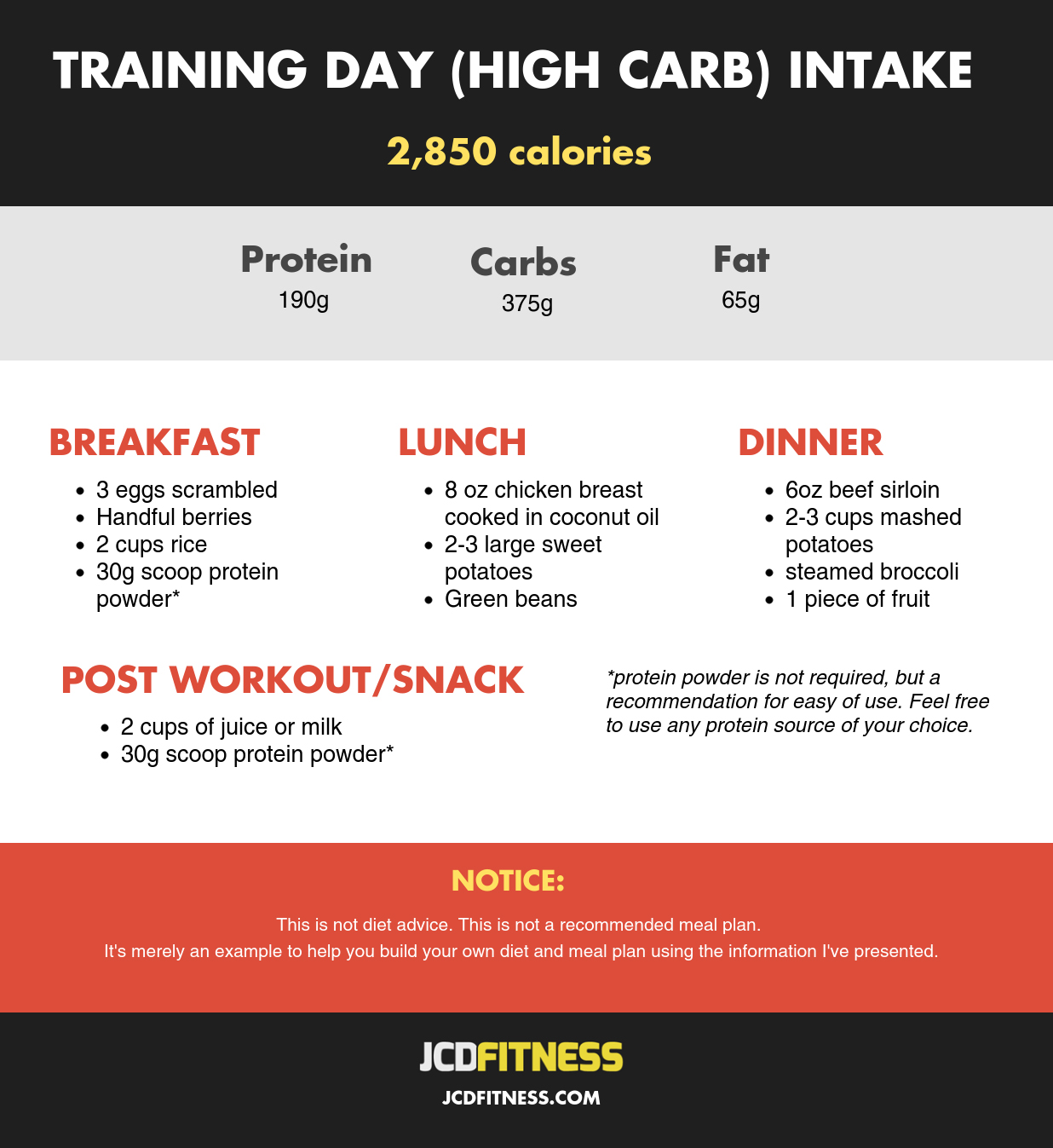Carb cycling is an incredible way to manage your diet for fat loss, muscle gain, and even just to maintain your weight (see my maintenance calories article for reference). But how do you go about it? This article will tell you everything you need to know about how to setup your own carb cycling meal plan.
There are 2 methods I’m going to highlight today to help you set up your own carb cycling meal plan.
Those are:
- The High/Low Method
- The High/Medium/Low Method
Before I go into the specifics of each method, here’s what you need to know… there’s no right way to do this. But it’s better to have a plan to work from, so see which one you are most attracted to and start there.
For protein recommendations, I’m using the figures from my article on how much protein we need.
The High/Low Method
When using this method, you’re having what we call a high carb day followed by a low carb day. For reference:
- High carb day: anything above 150g carbs
- Low carb day: anything at or below 100g carbs
For this example, we’ll use the numbers from my maintenance calories article.
His stats:
- Height: 5’8”
- Weight: 190 pounds
- Age: 29
- Gender: male
As per the maintenance calculator recommendations, his total maintenance calories are 2,850 (190×15) while weight training 3 days per week.
Carb Cycling Meal Plans For Fat Loss
So for this example, we will set him up with 3 high carb days at his maintenance intake and 4 low carb days 600 calories below maintenance.
If you need ideas for training, check out my workout plans article for some ideas.
Since he’s training 3 days per week, we’ll make those his high carb days. His off days will be the low carb days.
Training Day Intake | 2,850 calories
190g protein
375g carbohydrates
65g fat (~20% of calories)
Rest Day Intake | 2,250 calories
190g protein
100g carbohydrates
120g fat
Total weekly deficit: 2,400 calories (600×4). This should net him just less than 1 pound of fat lost per week.
Now I know what you’re thinking…
“He’s only going to lose 3-4 pounds of fat per month. I want to lose faster!”
It seems enticing to aim for fast fat loss, but it’s not the ideal situation because the faster you lose fat, the more likely you are to lose muscle, which is the exact opposite of what we’re trying to achieve.
Sample Training Day Meal Plan:
Sample Rest Day Meal Plan:
Carb Cycling For Muscle Gain
For muscle gain, we’ll use the same exact stats above, but we’ll adjust the intake so we put him into a caloric surplus to help him recover and grow more muscle tissue.
The goal will be to put him into a 300 calorie surplus on training days, and leave him at his maintenance intake on his off days. Here’s what his intake would look like:
Training Day Intake | 3,150 calories (+300)
190g protein
440g carbohydrates
70g fat (~20% of calories)
Rest Day Intake (maintenance) | 2,850 calories
190g protein
300g carbohydrates*
100g fat
Note: *I originally mentioned in the guidelines that low carb days would be somewhere at or below 100g of carbs. However, with someone who has a high expenditure, it doesn’t make a ton of sense to load up on dietary fat for two reasons:
- It’s easily stored in a caloric surplus, so to avoid fat gain, we must not eat too much fat
- Carbohydrates are important for recovery and refilling muscle glycogen, which helps with training performance
So in this case, he’s still cycling his carbs, but not as drastically as he might on a fat loss diet. If you decide to utilize this method for gaining muscle mass, you’re free to (and encouraged) to adjust the fat and carb numbers to see what works for you.
Some find that keeping their carbs to 100g or less on days off training helps them stay much leaner than eating more carbs. Just remember that you’ll want to keep your overall caloric intake to maintenance on off days so you stay in a net caloric surplus over the week.
The High/Medium/Low Method
In this example, you’re having what we call a high carb day, followed by a medium carb day, following low carb day. For reference:
- High carb day: anything above 150g carbs
- Medium carb day: anything between 100-150g carbs
- Low carb day: anything at or below 50g carbs
For this example, we’ll use the numbers from my maintenance calories article.
Her stats:
- Height: 5’5”
- Weight: 150 pounds
- Age: 31
- Gender: female
As per the maintenance calculator recommendations, her total maintenance calories are 2,250 (150×15) while weight training 3 days per week.
Carb Cycling For Fat Loss
So for this example, the 2 higher carb days will be set at maintenance, the 2 medium carb days will be set at 300 calories below maintenance, and the 2 low carb days will be set at 600 calories below maintenance.
Instead of lining up the high carb days with training, we’ll stagger the intake. My recommendation is that training is done on higher carb and medium carb days, not on the low carb days.
High carb days (maintenance) | 2,250 calories
150g protein
245g carbohydrates
75g fat (~30% of calories)
Medium carb days | 1,950 calories
150g protein
150g carbohydrates
80g fat
Low carb days | 1,650 calories
150g protein
50g carbohydrates
95g fat
For the week, you would set this up as follows:
Monday: High carb day | training day
Tuesday: Medium carb day | training day
Wednesday: Low carb day | rest day
Thursday: High carb day | training or rest day
Friday: Medium carb day | training or rest day
Saturday: Low carb day | rest day
Sunday: Low carb day | rest day
If you need ideas for training, check out my workout plans or weight training for women article for some ideas.
Carb Cycling For Muscle Gain
For muscle gain, we’ll use the same exact stats above, but we’ll adjust the intake so we put her into a caloric surplus to help her recover and grow more muscle tissue.
The goal will be to put her into a 200 calorie surplus on training days and leave her at maintenance intake on her off days.
Here’s what her intake would look like:
High carb days (maintenance) | 2,450 calories (+200)
150g protein
340g carbohydrates
55g fat (~20% of calories)
Medium carb days | 2,450 calories (+200)
150g protein
240g carbohydrates*
100g fat
Low carb days (maintenance) | 2,250 calories
150g protein
150g carbohydrates*
115g fat
Note: I originally mentioned in the guidelines that that ‘medium carb’ days would be somewhere between 100-150g of carbs and the low carb days would be anything below 50g carbs. However, in this example, it doesn’t make a ton of sense to load up on dietary fat for two reasons:
- It’s easily stored in a caloric surplus, so to avoid fat gain, we must not eat too much fat
- Carbohydrates are important for recovery and refilling muscle glycogen, which helps with training performance
So in this case, she’s still cycling her carbs, but not as drastically as she might on a fat loss diet. If you decide to utilize this method for gaining muscle mass, you’re free to (and encouraged) to adjust the fat and carb numbers to see what works for you.
Some find that keeping their carbs to 100g or less on days off training helps them stay much leaner than eating more carbs. Just remember that you’ll want to keep your overall caloric intake at maintenance on off days so you stay in a net caloric surplus over the week.
Obviously, if your expenditure is lower, you’ll have to adjust the carb and fat numbers downward.
Bottom Line On Fat Loss And Muscle Gain
For fat loss, you must maintain a caloric deficit.
For muscle gain, you have to be in a surplus.
Protein is the most important nutrient to maintain and gain muscle, but it doesn’t need to be sky-high for either goal. Simply stick to 1 gram per pound of body weight and you’re taken care of.
Carbohydrate and fat totals are important as well, but they can be manipulated a bit based on your preferences and individual energy expenditures.
Carb Cycling For Maintenance
To maintain your body weight, all you’ll need to do is pick a method above and then adjust your training day and off day intakes to reach a balance over a weekly period.
A good way to do this is to eat 200 calories over maintenance on training days and 200 calories below maintenance on off days. So if you have a maintenance intake of 2,500 calories, you’d eat 2,700 on training days and 2,300 on off days.
Use the same guidelines for protein, carbs and fat above in a similar manner for establishing a maintenance diet plan.




